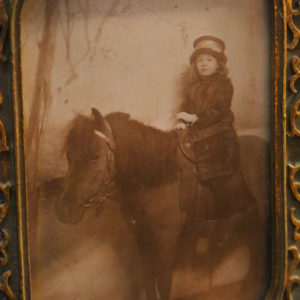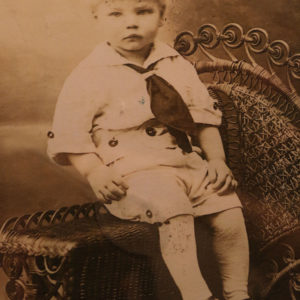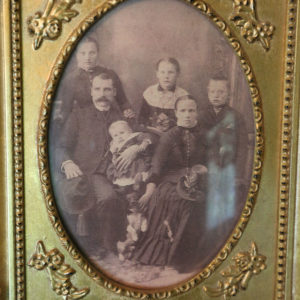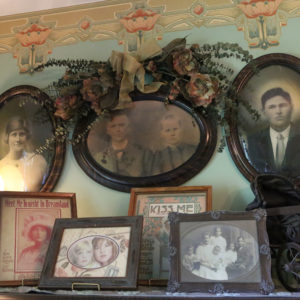I concluded my last blog with the promise that next time I would write about the most important virtue of them all—courage. However, that post is not yet complete, and in the meantime I’ve been inspired to write about something else that is near and dear to me: old photographs.
I am a sucker for antique photos and often find myself in pursuit of the elusive stories hidden behind the eyes of those forgotten faces who stare at me from the faded photographic paper. It’s as if I’m peeping through a portal to another world.
What was his/her name? What was he/she like? Who did he/she love? What was their greatest joy and heartache? What were their hopes and dreams? What did they dread and fear? Did they die young or live to a ripe, old age? These are the kinds of things I wonder as I behold the ancient faces preserved for posterity by the magic of the camera lens.
I am always secretly horrified when I see people selling photographs of their ancestors at garage sales or flea markets. If my wallet were fat enough, I would probably buy all the unwanted, unidentified grannies and grandpas and find homes for them.
Speaking of ancestors–as a longtime genealogy freak, I am always ecstatic when I can discover a photo to match a face in my family tree, and the stairwell of my home is lined with old family pictures. Below is my maternal grandmother posed on a pony that belonged to a traveling photographer. She grew up in Pittsburgh, Pa., so it must have been a clever sales pitch to lead the pony through the city streets and appeal to children eager to ride the cute (and very tired-looking) equine.
Next is a photo of my paternal grandfather, circa 1919, dressed in a sailor’s suit and seated on an ornate wicker “photographer’s chair.” How I would love to own one of these fancy “photographer’s chairs” that were popular during the early 1900s! Alas, chairs like this one sell for around $1,000 on e-bay, so for now, at least, it will have to wait.
One of my all-time favorite old family photographs is pictured below. Here we have my Finnish great-great-great grandparents and their four children, circa 1884, Ashtabula Harbor, Ohio. If you look closely, they even included their family dog in the picture. I wonder how they managed to keep the doggy still?
My dining room is also crowded with old family photos.
This collection is displayed atop my circa-1893 upright piano. The center oval portrait features my Finnish great-great-grandparents on their wedding day. They married when she was just 16 and he was 21. She bore 14 children, but only half of them survived into adulthood, many of them dying of tuberculosis. The large oval portrait on the far left is one of those children–my great-grandmother, their eldest, who outlived all of her siblings, dying in the 1970s when I was just 2. The large oval portrait to the right is my great-grandfather, who also immigrated to the United States from Finland. Without knowing how to speak English, he came to this country on his own in his 20s and never saw his parents or siblings in the “Old Country” again. He died suddenly of a heart attack in the 1950s while sitting in a barber’s chair, waiting for a haircut.
Stories like these are often handed down through the generations, or unearthed as a genealogist digs for clues. Either way, both the stories and photographs are precious fragments of the past, which brings me to my most important point: portraiture is an art not only to be shared with living friends and loved ones, it is an art we will share with posterity without even realizing it.
Think about it. One hundred-plus years from now, will a descendant hold your portrait in their hands and notice the family resemblances and wonder about the life you lived? Will they feel an inexplicable connection to you? Will they display your image in their home in an honored spot among treasured possessions and family heirlooms?
When we pose for a professional portrait, we might think of the friends or family with who we plan to share the prints. We might consider the Christmas cards we plan to design, or the large-sized canvas print we plan to hang above the sofa, but without even realizing it, we are also creating something very profound for people we will never know– but who will be a part of us.
When we regard portraiture from this perspective we realize how profound of an art it really is. Photographers are not only capturing an image, they are capturing a sliver of time, and–if they’re particularly talented at their craft–often they’re capturing the essence of a person’s story and character. To me, that is one thing that makes a stunning portrait–studying the person’s image and wanting to know more about them, or perhaps feeling as if you are acquainted with them just by the glint in their eye, or they way they tilt their head, or the sass with which they hold a pipe between their teeth.
French humanist photographer Henri Cartier-Bresson said, “Photographers deal in things which are continually vanishing, and when they have vanished there is no contrivance on earth which can make them come back again. We cannot develop and print a memory.”
No, but if we have a picture of that memory, we can frame it and hang it above our piano.
So, the next time you question the value of a photograph, or the value of investing in a professional portrait session, consider what is really being captured and preserved, and consider the boundlessness of this miraculous creative medium that allows an artist to create with the light and time.





